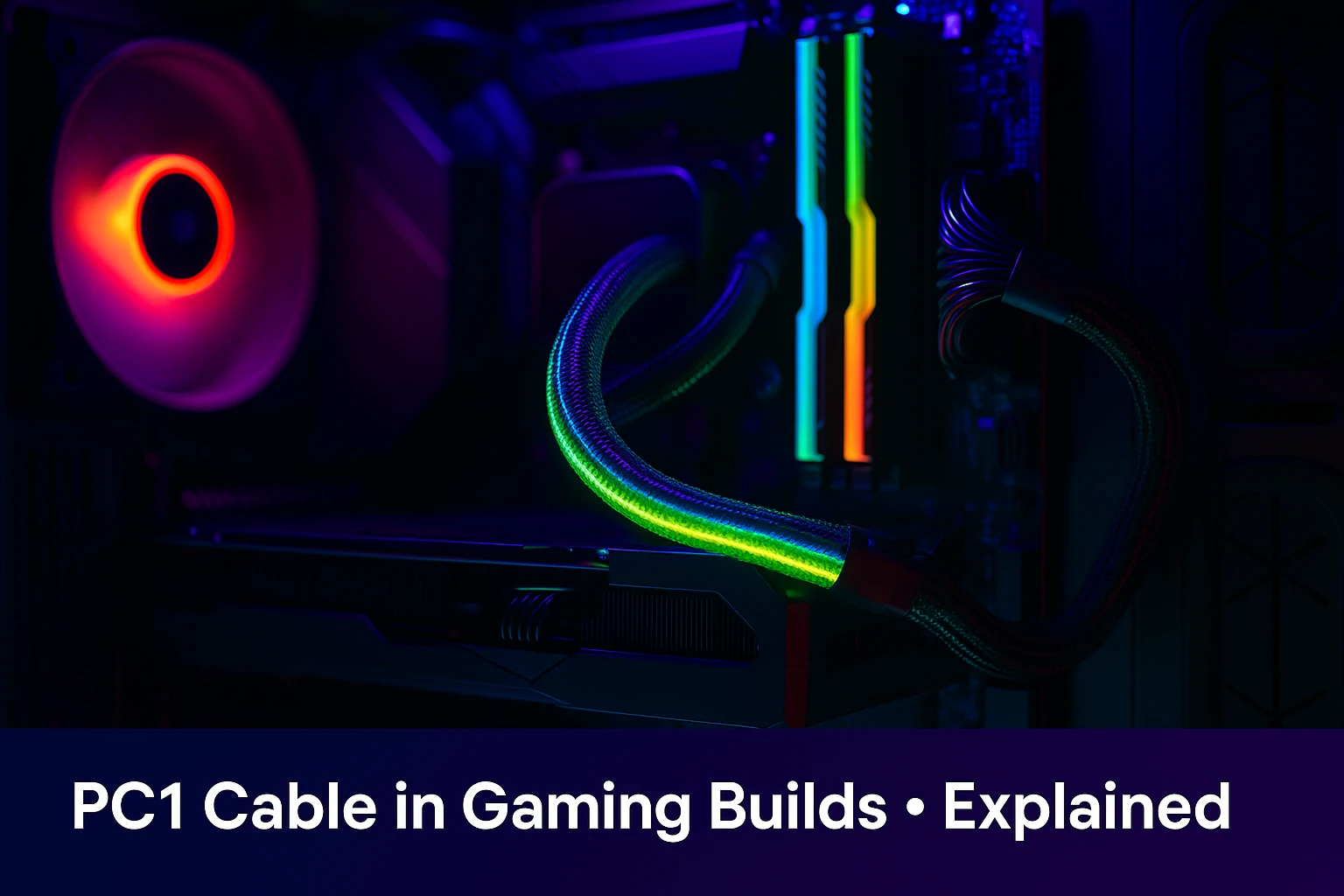Gaming PC builds have many parts. Some are easy to name. Others cause confusion. The “PC1 cable” is one of those names. Many users see this term and wonder what it means.
You may see it on websites, cable packs, or setup videos. But the name does not appear in official manuals. It looks like a tech word, but it is not clear. People want to know if it is needed or if it is just another label.
New builders often feel unsure. They want to plug in the right cables. A wrong move can damage expensive parts. So, they search for clear answers.
This guide breaks down what the PC1 cable really is. It also shows when you need it and how to avoid mistakes. You will leave with better cable knowledge and more confidence in your build.
What Does “PC1 Cable” Really Mean?
“PC1 cable” is not a real cable type. The name does not appear in official hardware lists. Most experts do not use this term. But some websites or sellers still do.
Most of the time, “PC1 cable” points to a PCIe cable or a CPU power cable. These are both power cables that connect your power supply to the parts of your system.
A PCIe cable sends power to your graphics card. This card handles game visuals and needs extra energy. A CPU power cable connects to the motherboard. It powers the processor.
Some users think “PC1” is a short name. Others think it is a model. But that is not true. You must check the cable ends. You must match them with the right slots. If you just go by the name, you may cause problems.
PS5 120 FPS Gaming: Full Guide to Games, Setup, Monitors & Performance
Why This Term Appears
The term “PC1 cable” may appear on online stores. It may show up in search results, product titles, or low-cost listings. Most times, it comes from poor translations or wrong labels.
Some sellers use this name to mean a general power cable. Others may not know the correct name. That makes it hard for new buyers to know what they are getting.
If a product says “PC1 cable,” stop and look closer. See the pictures. Read the specs. A good cable should show how many pins it has. It should tell you if it fits your GPU, CPU, or other part.
How PC Power Cables Work
Each part in your PC needs power. But each one takes a different cable. The power supply gives the power, but the cables carry it. That is where things get tricky.
The graphics card uses a PCIe cable. This cable may have six or eight pins. It plugs into the side of the card. Most gaming cards need this cable to work well.
The processor uses a CPU power cable. This cable plugs into the top corner of your motherboard. It may have four or eight pins. Some boards use both.
These cables look alike. But they do not work the same. You cannot swap them. That is why the wrong name, like “PC1 cable,” can confuse users. You must match the right cable to the right part.
When You May Need This Cable
If your gaming PC has a powerful graphics card, you need a PCIe cable. Your power supply may include one. If not, you must buy a good one that fits your card.
If your motherboard has an eight-pin CPU power slot, you need a CPU cable. Your PSU may have it built in. If it does not, a modular cable must be added.
Some pre-built PCs hide the cables well. But if you upgrade or rebuild, you must know which cable goes where. You cannot plug a cable just because it fits. You must know what it does.
When you see the term “PC1 cable,” ask yourself what the seller means. Then look at your parts. Match the shape and pin count. Do not trust the label.
Common Cable Mistakes
New builders often make the same errors. They mix up PCIe and CPU cables. This happens because both may use eight pins. But the pins are wired in a different way.
If you plug a CPU cable into a GPU slot, it may not work. Worse, it can cause damage. The same is true if you plug a PCIe cable into the CPU slot.
Another mistake is using old cables with a new power supply. Even if they fit, they may not work. Each PSU brand may wire the ends in a different way. Always use cables that came with your PSU or match its brand.
Choosing the Right Cable
You must choose the right cable for your gaming build. Do not rush. Take time to read your manuals. Look at the pin shapes. Compare them with your motherboard and graphics card.
Do not pick cables based on loose terms. If a product says “PC1 cable,” but does not show details, skip it. Pick one that clearly says PCIe or CPU. A good cable will match your needs and protect your system.
Your PSU brand matters. Some modular cables only work with that brand. Mixing brands can lead to errors. Always check before you buy.
Conclusion
The PC1 cable is not a real part. It is a vague name that leads to confusion. Most times, it means a PCIe or CPU power cable. These are both key parts in any gaming build.
You must learn to spot the right cables. Check the pin count. Read the labels. Match each cable with its correct slot. Do not rely on seller names or short forms.
A good gaming build starts with clear choices. Knowing what each cable does will help you build a system that runs smooth, looks clean, and stays safe. Avoid the term “PC1 cable” and stick to real, clear names.
If your system runs well, your skills matter next. Learn how to improve in our guide on becoming a gamer challenger.
Frequently Asked Questions
What does the PC1 cable name mean?
The name “PC1 cable” is not part of any real hardware guide. Most of the time, it points to a PCIe cable or a CPU power cable. These two cables send power from the power supply to key parts of a gaming PC. The name often appears in product listings that do not use proper terms.
Is the PC1 cable required in every gaming PC?
A gaming PC needs a PCIe cable if the graphics card draws extra power. It needs a CPU cable if the board near the processor has a matching port. The cable labeled as “PC1” may refer to one or both, depending on the source.
How do I spot the difference between PCIe and CPU cables?
A PCIe cable connects to the graphics card and usually has a 6-pin or 8-pin end. A CPU cable connects near the processor on the motherboard and often uses a 4+4 pin shape. The two may look close, but they serve different roles.
What can go wrong if I use the wrong cable?
Plugging the wrong cable into the wrong port can block power. It may also break your part. A PCIe cable does not power a CPU. A CPU cable does not work in a graphics card. Always check the label and match the port before plugging.
Why do some sellers use the name PC1?
The name often comes from weak product translations or short naming. It does not appear in any guide from trusted brands. Most tech experts do not use the term. Buyers should read product specs before trusting a label like “PC1.”
Can I use any power cable that fits the port?
A cable that fits still may not be safe. Power supply brands use different pin layouts. A wrong match can lead to failure. You should only use cables made for your power supply model or brand.
This guide offers general PC build insights for educational use. Always check your hardware manuals before connecting or buying cables.




